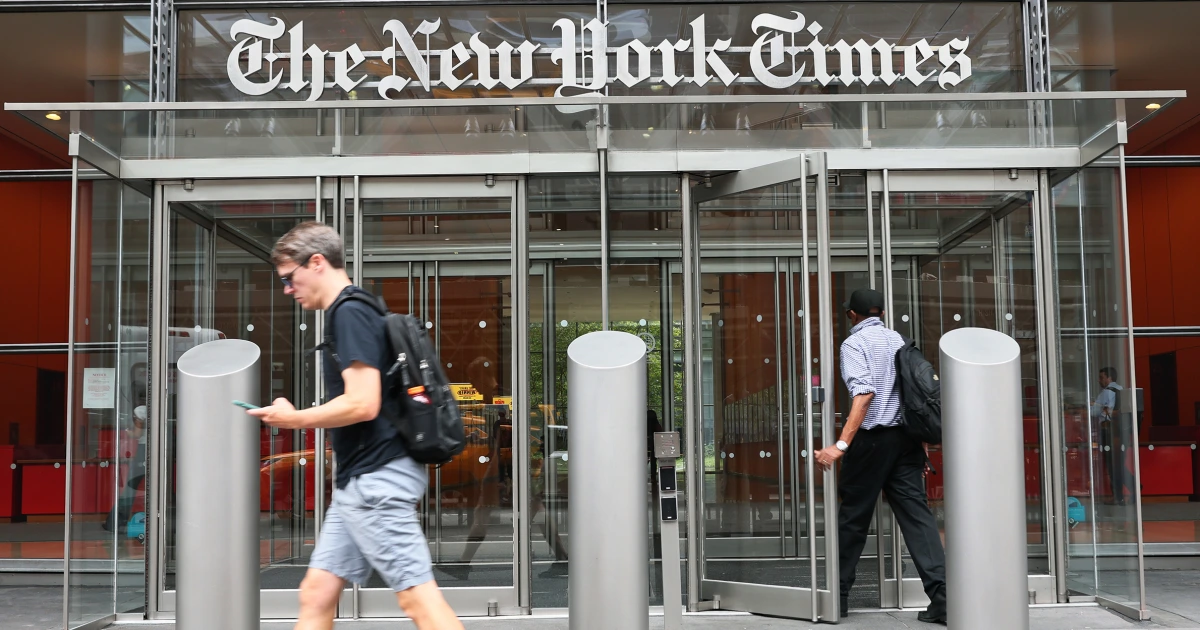
President Donald Trump’s escalating legal battle against America’s media industry continued Monday as he filed a lawsuit against The New York Times. The whopping 85-page complaint alleges the paper defamed him, and it seeks $15 billion, plus punitive damages, which exceeds the market cap of the entire company.
The lawsuit refers to the Times’ historic reputation as the “newspaper of record,” and that’s important for understanding the stakes of the case. The moniker speaks to the Times’ massive readership and prestige but also to an authoritative role — often setting the standards in terms of fact-checking, objectivity and independence that produce a definitive accounting of events for the record books. They’re the standards to which other newspapers are held.
In light of that role, and Trump’s continued successful shakedowns of media outlets of lesser prestige, a capitulation would be devastating. Instead, the Times has an opportunity, and an obligation, to rise to its historic role by categorically rejecting the lawsuit — and putting a stop to a particularly insidious legal idea that provides support for Trump’s media war.
The New York Times has an opportunity, and an obligation, to rise to its historic role by categorically rejecting the lawsuit.
The complaint, which First Amendment law professor Don Herzog calls “a press release masquerading as a lawsuit,” is a massive document that leaves ample room to hit familiar Trump beats, finding time to pick at the Times’ “deranged” endorsement of Kamala Harris and to hail Trump’s 2024 win as the “greatest personal and political achievement in American history.”
The alleged damages center on reporting published in the pages of the Times and in the book “Lucky Loser: How Donald Trump Squandered His Father’s Fortune and Created the Illusion of Success,” written by Times reporters Susanne Craig and Russ Buettner, that suggested Trump’s multimillion-dollar inheritance from his father was largely a product of fraudulent tax evasion schemes and that Trump owes his later fortune to producer Mark Burnett’s “discovery” of him as a host for “The Apprentice.” But Trump alleges that he was already famous and that his success with “The Apprentice” was “thanks solely to President Trump’s sui generis charisma and unique business acumen.”
Through what Trump alleges are false statements and negligent fact-finding, the lawsuit claims this reporting sought to illegally “damage President Trump’s hard-earned and world-renowned reputation for business success” and “sabotage his 2024 candidacy for President of the United States.”
The lawsuit has been met with universal dismissal by First Amendment scholars. “The complaint is full of bluster,” said Katie Fallow, deputy litigation director at Columbia University’s Knight First Amendment Institute, but “short on any allegations of specific false statements of fact that would meet the rigorous standards for defamation claims brought by public figures.”
One part of the complaint has been a particular focus of criticism, specifically where it states that the defendants had a “desire for President Trump to fail politically and financially. Each feels actual malice towards President Trump in the colloquial sense.”
As Fallow alluded, to prove defamation Trump must show “actual malice” on the part of the Times — and that’s a tough hill to climb, even assuming that the reporting is proven to be false.
As laid out in the landmark case New York Times Co. v. Sullivan, actual malice requires Trump to prove that the defendants actually knew their statements were false — or at least entertained actual, serious doubts about their truth. So resting this lawsuit on the idea that the defendants just really, really dislike Trump was met with predictable disbelief by legal experts.
But this section and the broader lawsuit belie something more sinister than a blustery failure to establish its claims’ basic elements. Trump believes it is — or would like it to be — legally actionable to harm his political ambitions when you really, really dislike him. In his view, reporters should be liable for statements that make people not wish to support him.
Beyond being a threat to the media, this idea is a threat to the very speech that makes up the core of our democratic process. No politician is entitled to support or votes, and to commodify them in this way is a perversion of democratic self-governance and a threat to core political speech.
And we’ve already seen Trump advance this idea in his other lawsuits against the media.
The lawsuit has been met with universal dismissal by First Amendment scholars.
When he targeted CBS News last October, he alleged billions of dollars in damages from the impact of what he claimed was ‚Äúdeceptive editing‚Äù of a ‚Äú60 Minutes‚Äù interview with Vice President Harris on campaign fundraising and ‚Äúsupport values.‚Äù Later that year, he targeted pollster J. Ann Selzer and The Des Moines Register, claiming her polling miss was ‚Äúelection interference‚Äù that required him to ‚Äúexpend … campaign expenditures.‚Äù With legal help from my organization, the Foundation for Individual Rights and Expression, Selzer is fighting these bogus claims.
The New York Times must similarly take this lawsuit as an opportunity to reject this idea, full stop. Its unique role in the media industry warrants a strong and defiant message in defense of the First Amendment and the Fourth Estate that depends on it.
Anything less risks a future in which Trump’s lawfare barrels through smaller outlets that don’t have the same resources.
FIRE has seen this in the campus context.
A negotiation and a settlement between Columbia and the Trump administration have led the administration to triumphantly charge at less resourced universities, such as George Mason University and George Washington University. As FIRE counsel Tyler Coward warned, “We said from the beginning it was going to take a big institution like Harvard or Columbia to stand up for its rights, and if they failed to do so — if they capitulated to unlawful demands from the administration — there was little hope for smaller institutions down the line.”
The New York Times, the Harvard of newspapers, should understand its role here accordingly.



